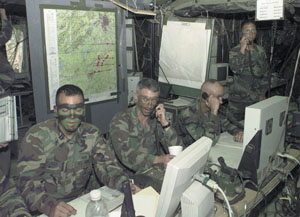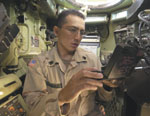Army Intelligence Consolidates Data
 |
| One of the ways the U.S. Army gathers and correlates intelligence information is with the All Source Analysis System, which tracks red forces through a variety of ground, airborne and space-based sensors. Officials are working toward standardizing access to these diverse data sources throughout many levels of command. |
Where many sources of intelligence currently confound military analysts’ efforts to build an accurate picture of the battlespace, a new joint Web-based system allows them to obtain information through a uniform query across the field of intelligence databases. Known as the Joint Intelligence Operations Capability-Iraq, or JIOC-I, the system gives analysts the ability to extract data faster and to spend more time on the analytical side of their tasking.
Prior to the development of JIOC-I, anyone performing a query for intelligence information would need to query multiple databases separately and would need to bring those results back and then determine what the information from diverse sources actually indicated. JIOC-I solves these problems, explains Lynn Schnurr, director of intelligence community information technology, U.S. Army G2.
With JIOC-I, the relationship among these disparate data sets is already established for the user. Extensible Markup Language (XML) serves as a unifying force so that the user can receive a full return of all the available information from a single query. JIOC-I is targeted for deployment in
The main driver for this single-query approach was the need to enhance information sharing, Schnurr relates. And, she adds, the key to that sharing is to put that information on the network and to flatten the network so that as many users as possible can access the vital information. In one strike, the new system extends the network, enhances analytical visualization tools and provides access to critical data that can be placed in a single database for immediate access and query.
The G2 took JIOC from concept in January of this year to initial implementation of the first phase in May. To bring the JIOC-I to the fore, the G2 is working to gather all of the available data from stovepipe sensors and disparate databases into a single repository. The information for this joint system is being drawn from all available sources, not just from Army databases or sensors. Ultimately, it will be extended to Multinational Corps–Iraq (MNC-I) and MultiNational Force–Iraq (MNF-I).
This consolidated data is XML-tagged to establish the relationship between the disparate datasets. The XML tagging also fits into the system’s Web-based accessibility. Anyone with a secure Web browser will be able to access and query the information. And, in what represents a significant departure from traditional architectures, this access can be achieved identically from the national level down to the tactical level.
The G2 also is providing the hardware infrastructure for the system. Schnurr relates that this comprises OrbSuite, a combination of basic analyst laptops and servers along with a robust set of analytical and visualization tools. “The key is getting all the data ingested,” she explains. “But, secondly, we must make sure we have the right kind of analytical tools that do things like link analysis and visualization tools.
“When you’re dealing with massive gigabytes of data, you must make sure that you have visualization tools that make data available so that analysts can actually look in visual terms at what they get when they do a query,” she emphasizes. These tools include Analyst’s Notebook, Starlight, Pathfinder and ArcGIS tools, for example.
Schnurr emphasizes that JIOC-I is not just for intelligence analysts—it also is for operators. Because it is on the network, any user who is on the network can access it from any echelon.
The JIOC-I effort is extending access to the network out to the battalion level and below. When soldiers have personal digital assistants (PDAs), they are able to access the network from the field. A soldier can query a topic by way of a request through the tactical operations center. The center then can provide the needed information back to the PDA-equipped soldier. PDAs and the Joint Network Node (JNN) enable access by the tactical-level user.
The first phase of JIOC-I has been completed with the building of the intelligence database on a secure network. This effort also included providing the system’s analysis tools to the MNC-I and MNF-I. The G2 is working collaboratively with the XVIII Airborne Corps in
Near-term efforts involve demonstrating the JIOC capability to V Corps. G2 officials used a military readiness exercise with the corps to introduce the capability. Ten JIOC work suites were inserted into the exercise, and the G2 employed a copy of its actual intelligence database to demonstrate how JIOC could be used in a demanding environment.
 |
| An Army sergeant with the 3rd Infantry Division loads frequencies into the communications system of his Bradley Fighting Vehicle just prior to a mission in Baqubah, Iraq. New Web-based tools offer the possibility of being able to move access to vital intelligence information down to much lower levels of command. |
“We’re real excited about the capability and think that this is going to be a real key to information sharing and getting information disseminated to that lowest echelon—the soldier,” she states.
G2 officials are working with the MNC-I and MNF-I on a future distribution plan. The two groups currently have all of the JIOC-I hardware and analytical tools at the corps or division level. They will select a test brigade to prove the full JIOC-I concept below division level, Schnurr reveals.
To assist in this effort, PDAs will be deployed to troops in the field (SIGNAL, July 2005). These PDAs are in final development, and they are being fielded initially to the 525 Military Intelligence Brigade. This will enable the G2 to plug them into the network, where they will have quick response on queries, a learning capability, messaging, video and other capabilities that they have lacked until now.
Other fieldings to divisions and corps will take place in the next rotation, Schnurr says. These PDAs are equipped with commercial software that includes commercial mapping capabilities. The Army is making the handheld units user-friendly by providing a PickList-type capability. Standard message formats allow users to do Freetext searches on their displays.
Implementing a quick reaction capability often runs the risk of rapidly inserting a new stovepipe system into the force. But Schnurr states that JIOC-I is not at risk to fall into that trap. By consolidating access to diverse databases, the system reduces duplicative efforts and enhances soldier capabilities. In effect, it makes existing data from many disparate stovepipes accessible.
“It has been recognized that, in order to enhance information sharing and provide access to the network, this is the kind of solution you have to go with,” she warrants. “This is the future; this is what we need to provide to the soldiers so that they can do their mission.”
Working out security issues was a challenge that was overcome in developing JIOC-I, Schnurr offers. The system’s security needed to be built in up front. Another challenge lay in defining all of the JIOC hardware and software, including components and peripherals, to ensure a robust enough suite.
As with any new information technology introduced into the field, training is vital to its success. The G2 is working with the U.S. Joint Forces Command to develop training along with draft tactics, techniques and procedures.
And, G2 is striving to make JIOC-I an Army program of record. The goal is to incorporate JIOC-I as a part of the Army’s Distributed Common Ground System (DCGS-A), Schnurr offers. “That’s all in the works for the future—how do we evolve this technology and capability to a future Army program of record,” she declares. “Our goal and objective is to do that as part of the DCGS.”
JIOC-I does not replace any particular system. In the future, if it becomes synonymous with the DCGS-A program, it will be part of an effort that replaces legacy systems. Schnurr describes this JIOC potential status as that of an enabler to DCGS-A for replacing legacy systems sooner rather than later.
This month, the G2 is moving into the second phase of JIOC-I. This thrust involves adding more sensors and databases into the system. Up until this point, the system has had between 30 and 40 of these elements; the second phase will more than triple that number. The first set of sensors and databases was deemed the most critical to the force, so the G2 gave it priority. But, the next group will enhance system capabilities.
“The important point is to ingest all kinds of sensors and data that enable us to do our job better in terms of the war on terrorism—whether it’s a ‘multi-INT’ type of situation or whether it’s just information that helps us with situational awareness,” Schnurr elaborates.
Planners also will field more workstations to enable a broader user base. And, training will increase. The use of commercial tools in the system does give some users a leg up if they are familiar with those tools. Schnurr relates that many soldiers have been able to pick up skills with JIOC-I very quickly because of this type of familiarity.
Web Resources
DCGS-A: www.monmouth.army.mil/peoiew/dcgsa
MNF-I: www.mnf-iraq.com


Comments